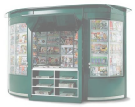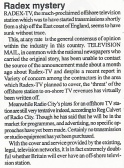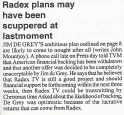Radex TV
In April 1965 stories began to circulate about another planned offshore broadcasting project.
Using the name Radex TV, plans were announced to launch a 24 hours a day pop radio service and also thirteen hours of television programmes aimed at south east England.
Radex TV programmes included the then innovative idea of a two hour breakfast show from 7.00am, then transmissions would then re-start again at 3.00pm, continuing to 1.30am. Programmes were to include films, documentaries, quiz shows, record shows and topical interviews.
Radex TV planned to use Channel 6 for its television output, but this was a reserved channel allocated to the Radio Astronomy Service at Cambridge and was not available for use by either the BBC or Independent Television companies.
Professor Martin Ryle, Director of the Radio Astronomy Service at Cambridge was reported as saying "If this station comes on the air at the same time as we are working we just cannot operate. We are using two large radio telescopes and one would be put out of action. I am absolutely appalled by the incredibly feeble action being taken by western Europe against these pirate radio stations. People just do not seem to be worrying. I am very worried by all this."
The Radex p roject, which was registered in the Bahamas, planned to use a ship anchored off Whitstable, and was reported to have had American backers who put up over £1million to launch the radio and TV stations and keep them on the air. The spokesman for Radex in Britain was Jim de Grey, an engineer from New Zealand.
roject, which was registered in the Bahamas, planned to use a ship anchored off Whitstable, and was reported to have had American backers who put up over £1million to launch the radio and TV stations and keep them on the air. The spokesman for Radex in Britain was Jim de Grey, an engineer from New Zealand.
However, the backers later withdrew their support and the ambitious project never materialised.



















